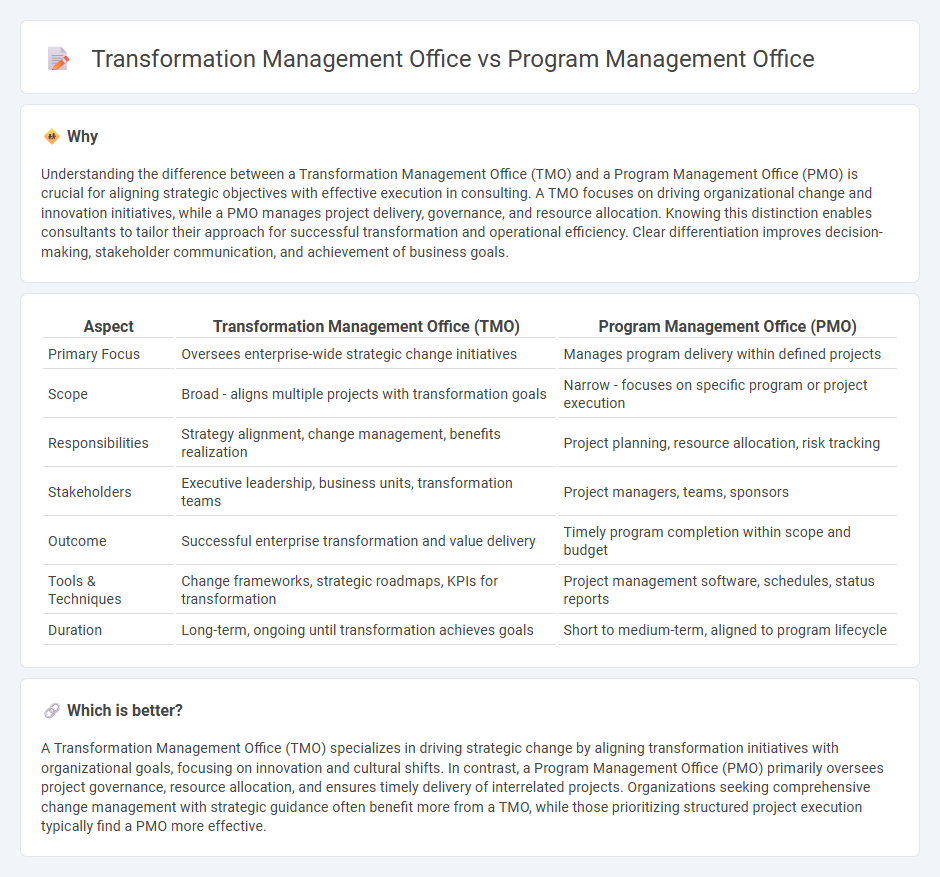
Transformation Management Office (TMO) focuses on driving strategic change initiatives and ensuring alignment with organizational goals, utilizing specialized methodologies to manage complex transformations. Program Management Office (PMO) oversees the execution of multiple related projects, emphasizing consistency in processes, resource allocation, and performance tracking across the program lifecycle. Explore deeper insights into how TMO and PMO roles differ to optimize your organization's change and project management efficiency.
Why it is important
Understanding the difference between a Transformation Management Office (TMO) and a Program Management Office (PMO) is crucial for aligning strategic objectives with effective execution in consulting. A TMO focuses on driving organizational change and innovation initiatives, while a PMO manages project delivery, governance, and resource allocation. Knowing this distinction enables consultants to tailor their approach for successful transformation and operational efficiency. Clear differentiation improves decision-making, stakeholder communication, and achievement of business goals.
Comparison Table
| Aspect | Transformation Management Office (TMO) | Program Management Office (PMO) |
|---|---|---|
| Primary Focus | Oversees enterprise-wide strategic change initiatives | Manages program delivery within defined projects |
| Scope | Broad - aligns multiple projects with transformation goals | Narrow - focuses on specific program or project execution |
| Responsibilities | Strategy alignment, change management, benefits realization | Project planning, resource allocation, risk tracking |
| Stakeholders | Executive leadership, business units, transformation teams | Project managers, teams, sponsors |
| Outcome | Successful enterprise transformation and value delivery | Timely program completion within scope and budget |
| Tools & Techniques | Change frameworks, strategic roadmaps, KPIs for transformation | Project management software, schedules, status reports |
| Duration | Long-term, ongoing until transformation achieves goals | Short to medium-term, aligned to program lifecycle |
Which is better?
A Transformation Management Office (TMO) specializes in driving strategic change by aligning transformation initiatives with organizational goals, focusing on innovation and cultural shifts. In contrast, a Program Management Office (PMO) primarily oversees project governance, resource allocation, and ensures timely delivery of interrelated projects. Organizations seeking comprehensive change management with strategic guidance often benefit more from a TMO, while those prioritizing structured project execution typically find a PMO more effective.
Connection
The Transformation Management Office (TMO) and Program Management Office (PMO) collaborate closely to drive organizational change by aligning strategic initiatives with operational execution. The TMO focuses on overseeing transformation projects to ensure strategic goals are met, while the PMO manages program delivery, resources, and risk mitigation to support these initiatives. Effective integration of TMO and PMO roles enhances governance, improves stakeholder communication, and accelerates successful change implementation.
Key Terms
Governance
The Program Management Office (PMO) primarily focuses on governance by standardizing project management processes, ensuring alignment with organizational objectives, and monitoring project performance through metrics and reporting frameworks. In contrast, the Transformation Management Office (TMO) emphasizes governance around change initiatives, prioritizing strategic transformation goals, stakeholder engagement, and risk mitigation to drive organizational change effectively. Explore detailed governance models and best practices to understand how each office supports successful project and transformation outcomes.
Change Management
The Program Management Office (PMO) primarily oversees project execution, resource allocation, and standardized processes, while a Transformation Management Office (TMO) concentrates on driving organizational change, cultural shifts, and strategic transformation initiatives. Change management within a TMO involves stakeholder engagement, communication strategies, and aligning transformation goals with business outcomes, ensuring sustainable adoption of new processes. Explore further to understand how integrating change management in these offices maximizes project success and organizational growth.
Strategic Alignment
A Program Management Office (PMO) ensures strategic alignment by standardizing project management processes and prioritizing initiatives that support organizational goals, thereby improving efficiency across multiple projects. In contrast, a Transformation Management Office (TMO) drives strategic alignment by managing change initiatives that enable business transformation, focusing on innovation and long-term value creation. Explore detailed comparisons to understand how each office contributes uniquely to aligning strategy with execution.
Source and External Links
Program Management Office (PgMO): our ultimate guide | i-nexus - A Program Management Office is a centralized organizational function responsible for overseeing multiple related projects within a larger program, ensuring program governance, planning, alignment, and consistency across projects to support successful program delivery.
A Program Management Office Guide - Smartsheet - The Program Management Office guides organizations to implement best practices in program execution, focusing on organizational programs rather than individual projects, and emphasizing continuous improvement and alignment with business strategy.
Project management office - Wikipedia - A Project Management Office defines and maintains standardized project management practices within organizations, improving project success rates, with the Program Management Office specifically managing related projects as a cohesive program.
 dowidth.com
dowidth.com